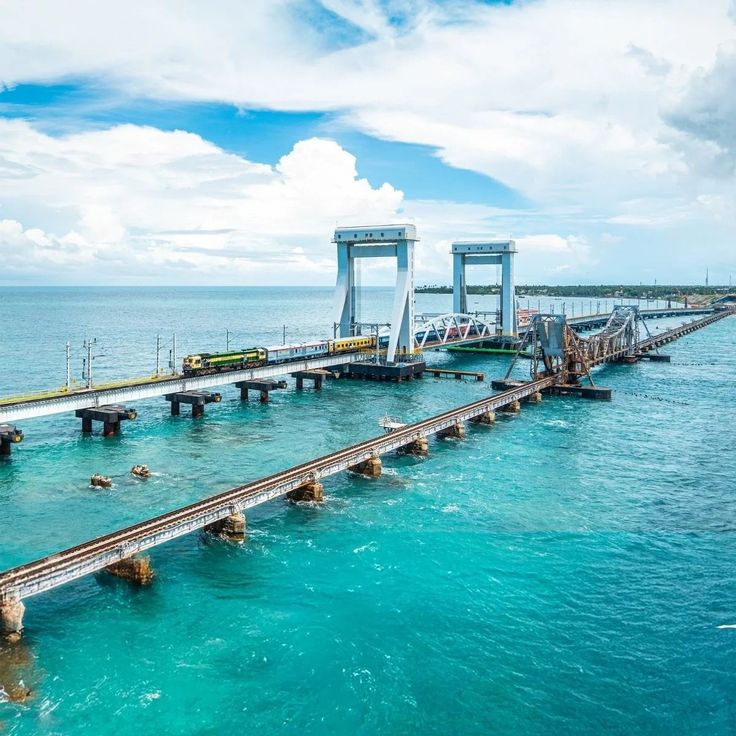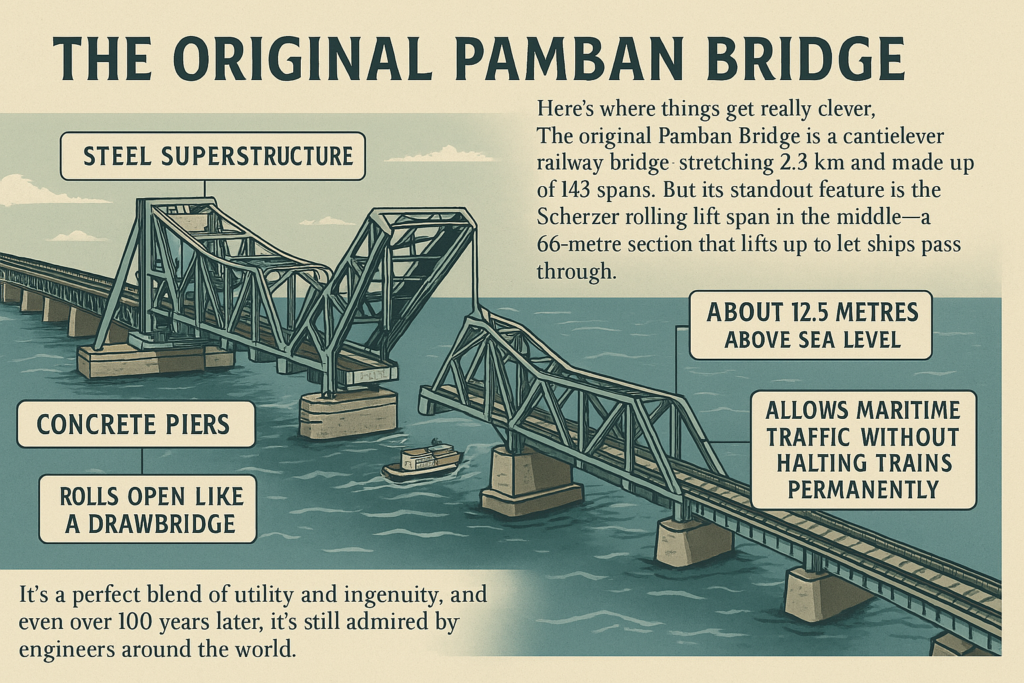
Introduction
You’ve probably seen the photos—a train gliding over the sea, the horizon melting into turquoise waters, and a narrow bridge stretching endlessly into the distance. You stop and wonder: What is that? Where is it? Is it real?
Yes, it’s real. And it’s called the Pamban Bridge—India’s Historic Sea Link to RameswaramIndia’s first sea bridge, and still one of its most iconic.
If you’re curious about India’s unsung engineering feats or spiritual routes that have stood the test of time, you’re in the right place. Because the Pamban Bridge isn’t just steel and bolts. It’s a living story of resilience, faith, and brilliant design. Opened in 1914, this sea link connects the mainland to Rameswaram, one of Hinduism’s most sacred pilgrimage sites—and does so with a stunning blend of history and function.
In this article, you’ll uncover why the Pamban Bridge is far more than a travel photo. You’ll learn about its British-era origins, the brilliant German engineering behind its lifting span, the storms it has survived, and what the new vertical-lift bridge means for India’s future.
Geographical Location and Importance of Pamban Bridge
The Pamban Bridge is located in Tamil Nadu, stretching across the Palk Strait between Mandapam on the mainland and Pamban Island, which houses the town of Rameswaram.
Why is this location so important?
It’s the gateway to Rameswaram, a key stop in the Char Dham pilgrimage.
It supports transport and logistics to the island, including rail freight and defence movement.
It’s a tourist attraction in its own right—few train rides offer such uninterrupted sea views.
Basically, it’s not just a bridge. It’s a lifeline.
Historical Background
The idea of the Pamban Bridge was born during the British Raj. Back then, Rameswaram already held deep religious importance, but it was hard to reach by land. So, the British decided to build a railway sea bridge to connect it with the mainland.
Inaugurated: 24 February 1914
Engineered by: German engineer Scherzer, known for his rolling lift design
Built for: Railway access—especially for pilgrims and goods transport
At the time, it was a massive undertaking. This was before India had access to modern construction equipment or digital planning tools. Every inch of the bridge was a feat of early 20th-century engineering.
🔧 Engineering and Structure

Here’s where things get really clever.
The original Pamban Bridge is a cantilever railway bridge, stretching 2.3 km and made up of 143 spans. But its standout feature is the Scherzer rolling lift span in the middle—a 66-metre section that lifts up to let ships pass through.
Material: Steel superstructure on concrete piers
Elevation: About 12.5 metres above sea level
Movable Span: Rolls open like a drawbridge
Function: Allows maritime traffic without halting trains permanently
It’s a perfect blend of utility and ingenuity, and even over 100 years later, it’s still admired by engineers around the world.
🚧 Challenges Faced and Restoration
The Pamban Bridge hasn’t had an easy life. It’s stood up to nature again and again.
1964 Cyclone: A devastating storm wrecked large parts of the bridge. Reconstruction was done urgently to restore the rail link.
Saltwater Exposure: Being so close to the sea means constant corrosion risk. Regular maintenance is a must.
2007 Upgrade: The bridge was reinforced to carry heavier, modern trains without compromising safety.
Despite its age and the elements, the bridge continues to serve thousands of passengers every year—because it’s been maintained with care and respect.
🚄 The New Pamban Bridge: Future of Sea Rail
India isn’t just preserving its legacy—it’s also upgrading it.
The New Pamban Bridge is under construction and expected to open in 2025. This isn’t just a facelift. It’s a leap into the future, designed with today’s technology while respecting yesterday’s heritage.
Key Features:
Vertical Lift Span: Instead of rolling, the central section lifts vertically for smoother ship movement
Electrified Line: First electrified rail bridge in the region
Higher Clearance: To account for sea level rise
Modern Materials: Corrosion-resistant alloys for longer lifespan
This bridge will handle faster, heavier trains and streamline maritime navigation—all while preserving the spiritual route to Rameswaram.
🌍 Strategic and Cultural Significance
1. Spiritual Gateway
For millions of Hindus, Rameswaram isn’t just a town—it’s sacred ground. The bridge connects devotees to the Ramanathaswamy Temple, one of the four Char Dhams. Many believe that a pilgrimage to Rameswaram completes their spiritual journey.
2. Tourist Favourite
Travellers rave about the train ride across the bridge. The views of the Bay of Bengal, the feeling of being surrounded by water, and the history beneath your feet make it one of the most memorable train journeys in India.
3. Strategic Defence Link
Given its proximity to Sri Lanka, the bridge also holds military importance. It enables swift movement of equipment and personnel along the southern coast.
Frequently Asked Questions (FAQs)
Given its proximity to Sri Lanka, the bridge also holds military importance. It enables swift movement of equipment and personnel along the southern coast.
Yes, the original railway bridge is still running trains while the new bridge is being built.
It features India’s first vertical lift span for better navigation and supports electrified rail.
Not on the railway bridge. For vehicles, there’s the Annai Indira Gandhi Road Bridge, which runs parallel and opened in 1988.
The original bridge is 2.3 km long.
It was India’s first sea bridge and one of the most ambitious infrastructure projects of its time.
Conclusion
The Pamban Bridge isn’t just an engineering wonder. It’s a story. A story of connection—between land and island, past and future, faith and progress.
For over a century, it’s carried pilgrims, travellers, and trains across the sea. And as the new vertical-lift bridge rises beside it, one thing remains clear: Pamban is more than just a bridge. It’s a symbol of how India builds with purpose, preserves with pride, and progresses with vision.
Want more stories about India’s engineering icons and historical wonders?
Keep an eye on this blog—we’ve got plenty more coming.
